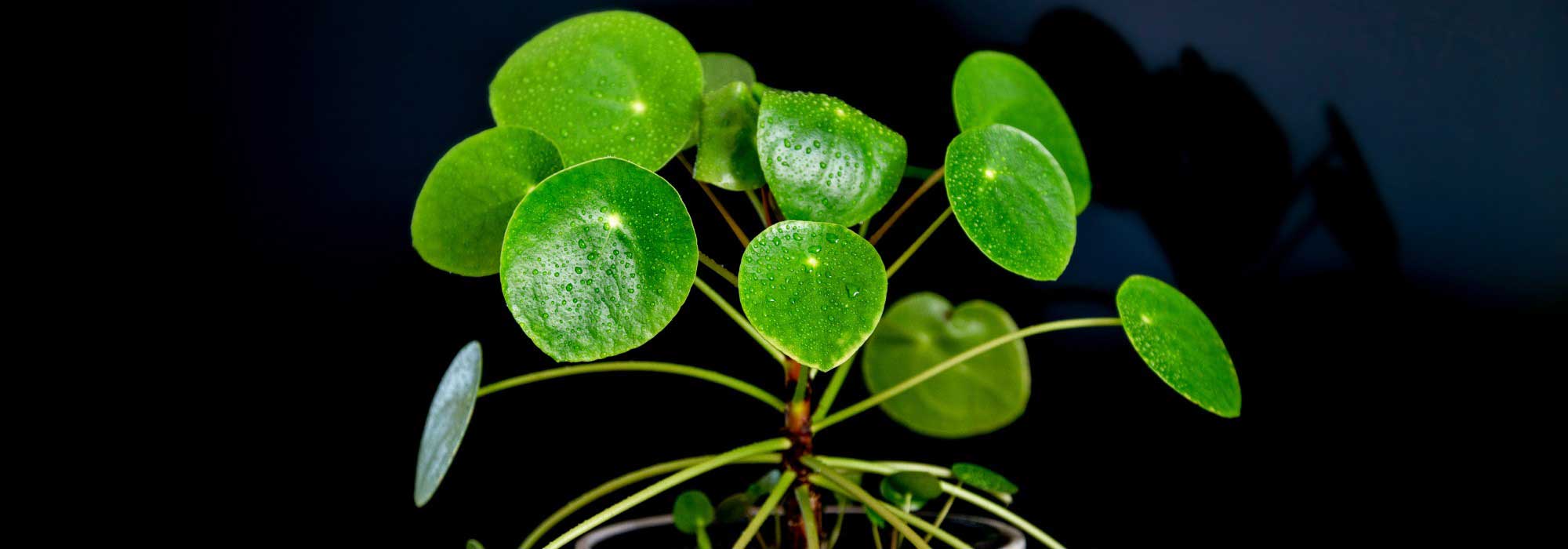
Pilea : growing and caring
Contents
Pileas in a nutshell
- Native to Asia, particularly southern China, the Pilea is a tropical plant belonging to the Urticaceae family
- Its round, glossy foliage earns it the nickname “Chinese money plant” or “missionary plant”
- Easy to grow, it is perfect for beginners and requires minimal maintenance
- It propagates easily, particularly through the offsets it naturally produces around its base
- Highly decorative, it fits effortlessly into any interior style, whether displayed alone or alongside other plants
The word from our expert
The Pilea, also known as the Chinese money plant or Pilea peperomioides, is a small houseplant that is gaining popularity thanks to its graphic foliage and elegant silhouette. Native to Asia, it stands out for its round leaves, glossy and carried by long, slender stems that give it a minimalist yet original look. There are also many other species of Pilea, less well-known, which offer very varied foliage in terms of shapes and colours.
The Pilea is an easy-going plant, ideal for beginners but also suitable for more experienced gardeners. Undemanding and quick to propagate, it is also an excellent choice for expanding your indoor plant collection. Discover everything you need to know to successfully grow and care for your Pilea!
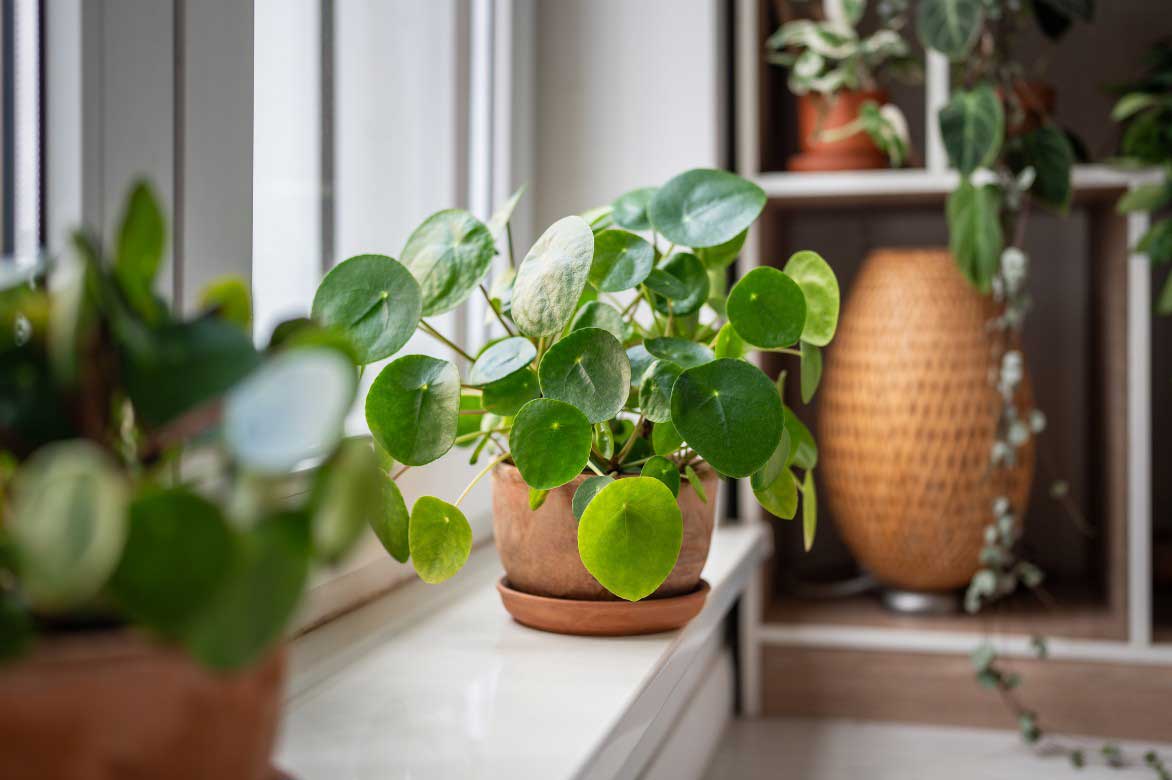
Description and Botany
Botanical data
- Latin name Pilea sp.
- Family Urticaceae
- Common name Chinese money plant
- Flowering Rare indoors
- Height 30 to 40 cm
- Exposure Bright, indirect light
- Soil type Light and well-draining
- Hardiness Not frost-hardy
Pilea is a plant primarily native to tropical and subtropical regions of Central and South America, Asia, and a few species also come from Africa. The most well-known species, Pilea peperomioides, originates from the mountainous regions of southern China, particularly Yunnan. It thrives naturally in these temperate and humid zones, often in the shade of larger trees.
Pilea belongs to the Urticaceae family, which includes stinging nettles, although Pilea itself is completely non-stinging! Some Pilea species even have dentate leaves that resemble those of nettles (for example, Pilea matsudai).
Pilea peperomioides was discovered in the 1940s in China by a missionary named Agnar Espegren, which is why it is sometimes called the “Missionary plant.” Agnar Espegren later brought it to Norway and shared it with his friends. Pilea then spread across Europe through exchanges and cuttings among plant enthusiasts.
The Pilea genus includes over 600 species of tropical plants, mostly herbaceous, often cultivated for their decorative foliage. These species exhibit great diversity, with varied leaf shapes, sizes, and appearances. Some are prized for their simplicity and ease of care, others for their more unique or graphic appeal.
Pilea has a bushy, rounded form. Pilea peperomioides typically reaches 20 to 30 cm in height, making it perfect for small spaces like windowsills, shelves, or desks.
Its main ornamental feature is, of course, its unique foliage! The leaves of Pilea peperomioides are round, almost perfectly circular, smooth, and glossy. They are a vibrant green and are held by long, slender petioles that emerge from the center of the leaf rather than the edge of the lamina (this is called peltate foliage). The leaves can grow up to 10 cm in diameter.
This structure gives the plant a very graphic and original appearance, with leaves that seem to float like little flying saucers around the central stem.
Pilea leaves are round like coins, and in China, it is said that this plant brings prosperity. This is why it is nicknamed the “Chinese money plant.” In English, it is also called the “Pancake plant”!
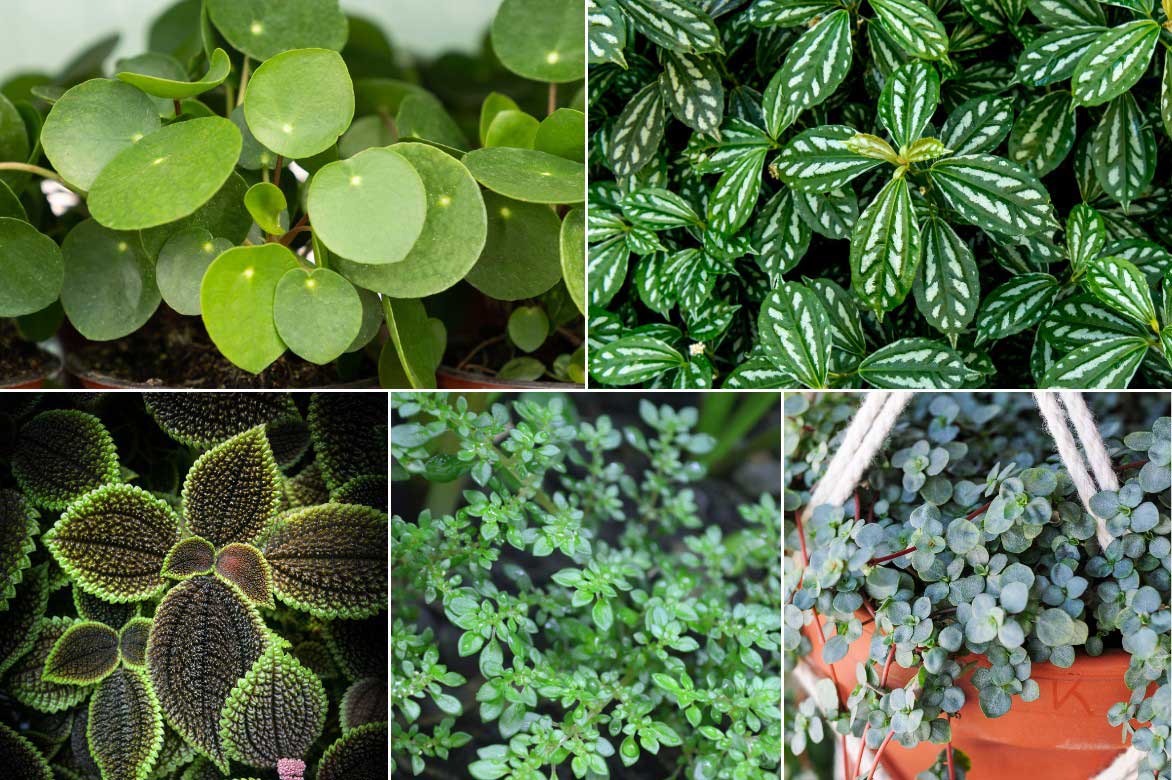
Pilea peperomioides is the most well-known and widely cultivated, but there are many other Pilea species, distinguished by the size, shape, and colour of their foliage. Pilea peperomioides, Pilea cadierei, Pilea involucrata, Pilea microphylla, Pilea glauca ‘Greyzy’
Some other Pilea species offer very different foliage: veined, variegated, serrated, or textured. Besides Pilea peperomioides, here are a few other ornamental species:
- Pilea cadierei: this variety gets its name from its dark green leaves marbled with silver spots, giving it a metallic, highly decorative look. The leaves are ovate and veined, with a compact habit. Ideal for pots or hanging baskets, it thrives in high humidity.
- Pilea involucrata: this species features thick, crinkled, highly textured foliage, often dark green with bronze or coppery reflections. It is prized for its colour contrasts and compactness. Perfect for terrariums or decorative cache-pots.
- Pilea microphylla: with its tiny, tightly packed light green leaves, this species forms a dense, almost moss-like carpet. It gets its curious name from its minuscule flowers, which “explode” when they open to release pollen—hence the nickname “Artillery plant”!
- Pilea glauca: highly valued for its trailing habit and powdery blue-grey foliage, this plant is perfect for hanging displays. It forms cascades of small, soft, round leaves, ideal for a bohemian or urban jungle vibe.
There are also hybrid varieties, selected for their aesthetics: variegated leaves, pink veins, miniature habit, etc. Examples include Pilea peperomioides ‘White Splash’, ‘Variegata’, or ‘Mojito’, with white-variegated foliage.
It is rare for Pilea to flower indoors. However, under optimal growing conditions, it may bloom in spring or summer. When it does, the flowering takes the form of panicles of tiny white, green, or pink flowers. These have five petals and a star-like shape, giving the bloom a light, delicate, and airy appearance.
Pilea is not a hardy plant: it cannot tolerate cold, let alone frost. Its ideal temperature range is between 15 °C and 25 °C. Below 10 °C, the plant may start to suffer significantly. This is why it is almost exclusively grown indoors or in greenhouses in our latitudes.
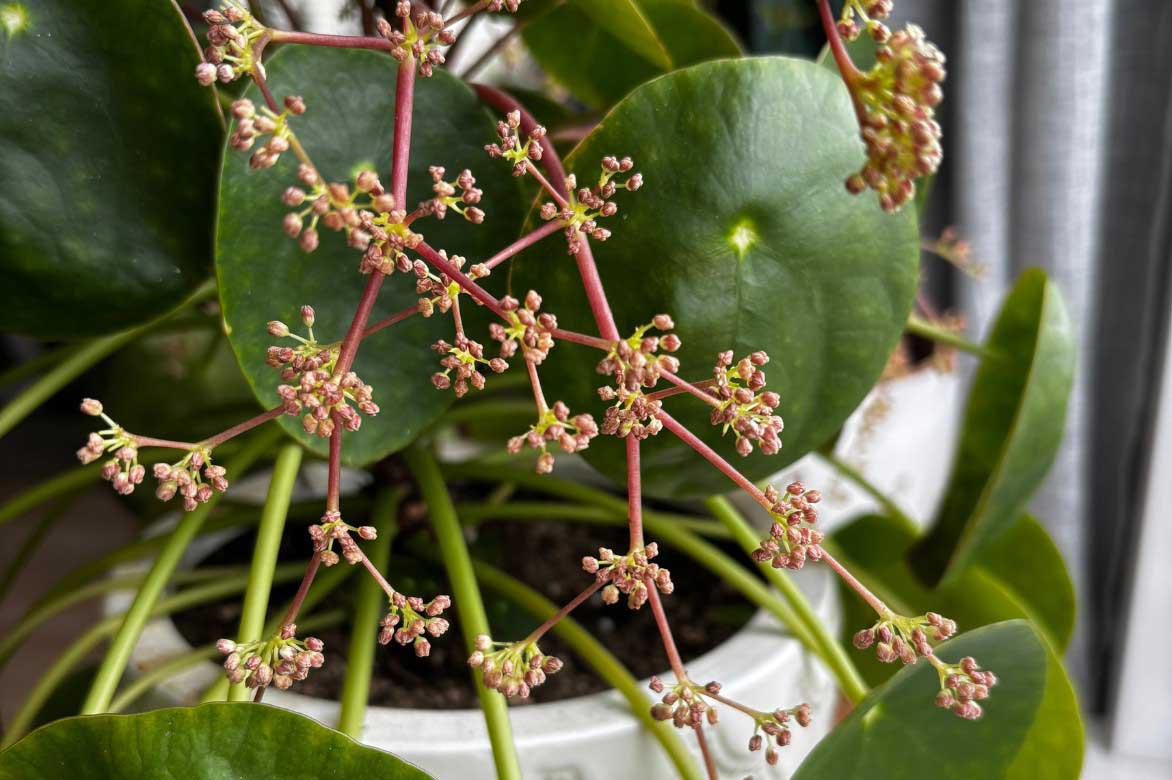
The flowering of Pilea
The different species and varieties
Our Favourite Varieties
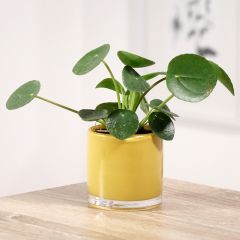
Chinese money plant - Pilea peperomioides
- Hauteur à maturité 50 cm
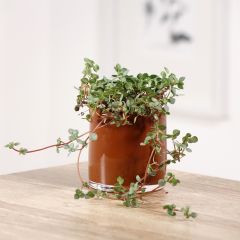
Pilea glaucophylla Greyzy - Silver sparkle plant
- Hauteur à maturité 10 cm
Planting the Pilea
Where to place the Pilea?
The Pilea loves bright, indirect light. Too much direct sunlight can scorch its delicate leaves, while insufficient light will make the plant sparser, with stems stretching abnormally to seek light (etiolation). The ideal spot is near an east or west-facing window, or behind a sheer curtain if the light is too intense. It will thrive in a room with bright light throughout the day, such as a living room or a bright kitchen. Avoid cold drafts and direct heat sources that dry out the air.
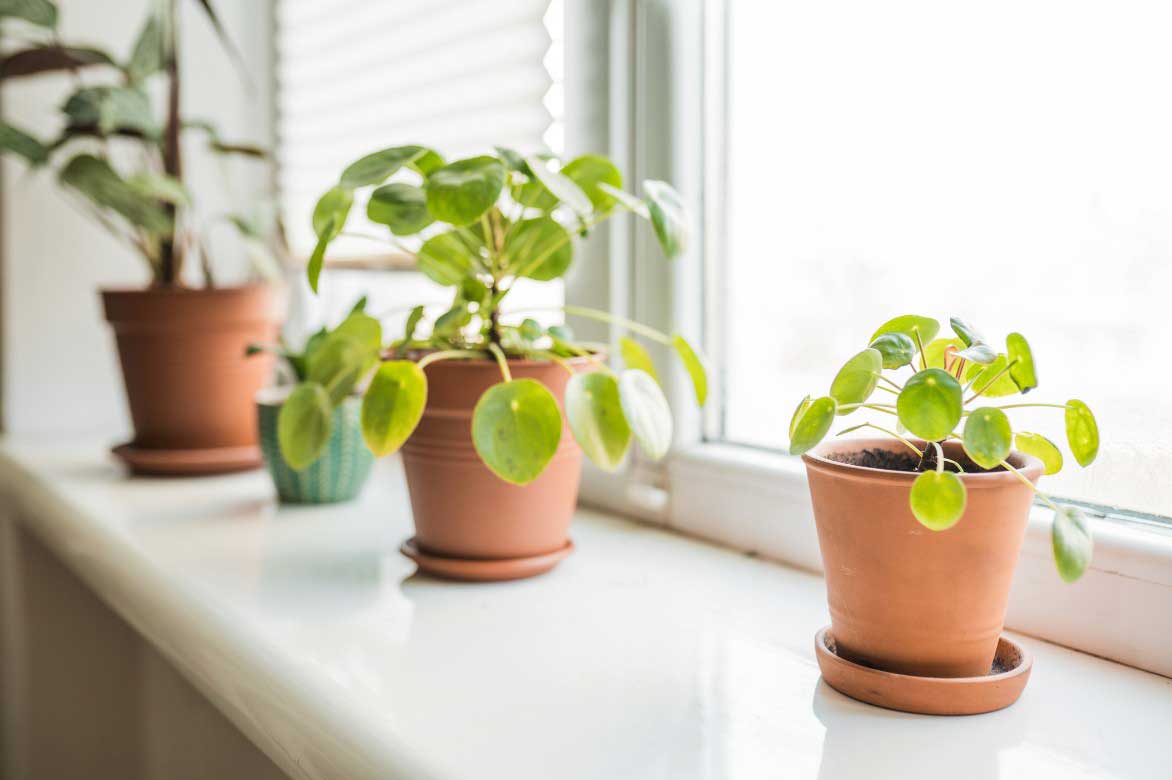
Place the Pilea in a bright spot, for example near a window, but away from direct sunlight
When to plant the Pilea?
The Pilea can be potted year-round, as long as the indoor temperature remains stable. However, the ideal time to repot or place it in a new container is in spring, between March and May. This is the season when it enters an active growth phase, helping it settle in well.
How to plant it?
Choose a pot with drainage holes, essential to prevent excess water. A diameter of 10 to 15 cm is sufficient for a young plant. You can gradually move it to slightly larger pots as it grows.
Use a light, well-draining substrate. For example, you can create a mix of 2/3 houseplant compost and 1/3 perlite, sand, or vermiculite (to lighten the substrate). You can also add a bit of activated charcoal or coconut fibre to improve aeration.
Here are the steps to plant or repot your Pilea correctly:
- Place some of the substrate in the pot.
- Gently remove the plant from its original pot, without damaging the roots.
- Position the Pilea in the centre of the pot, then fill around it with the substrate.
- Lightly firm down and water.
- Place the Pilea in a bright spot, away from direct sunlight.
- Water again only when the top layer of soil feels dry.
-
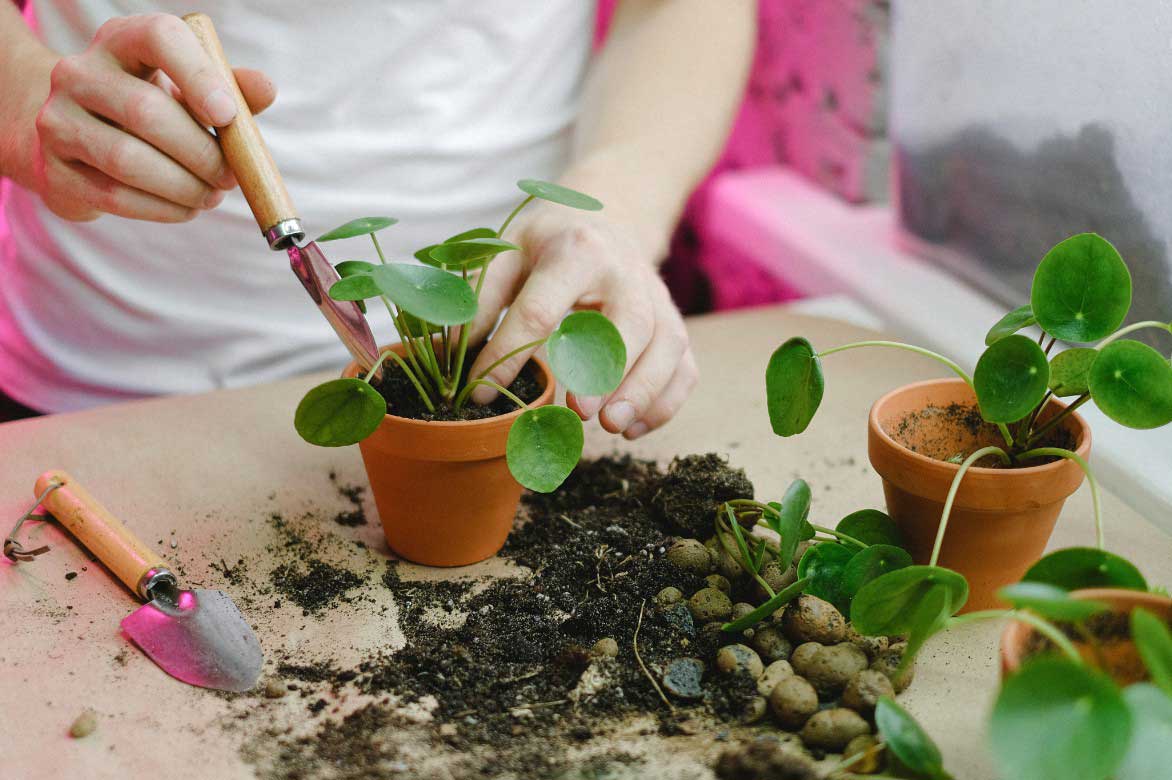
Plant the Pilea in a pot slightly larger than the root ball
How to care for the Pilea?
The Pilea is a relatively easy plant to care for, but like all plants, it has its little preferences. Here are the best practices to keep it happy and healthy.
Watering
The Pilea dislikes both prolonged dryness and excessive moisture. Therefore, it’s important to find the right balance:
- Spring-summer: water approximately once a week, when the surface of the compost feels dry to the touch.
- Autumn-winter: reduce watering to every 10 to 15 days, as the plant enters dormancy.
Tip: it’s better to underwater than overwater. Excess moisture can lead to root rot.
Preferably use room-temperature water that is not hard (rainwater or filtered water if possible).
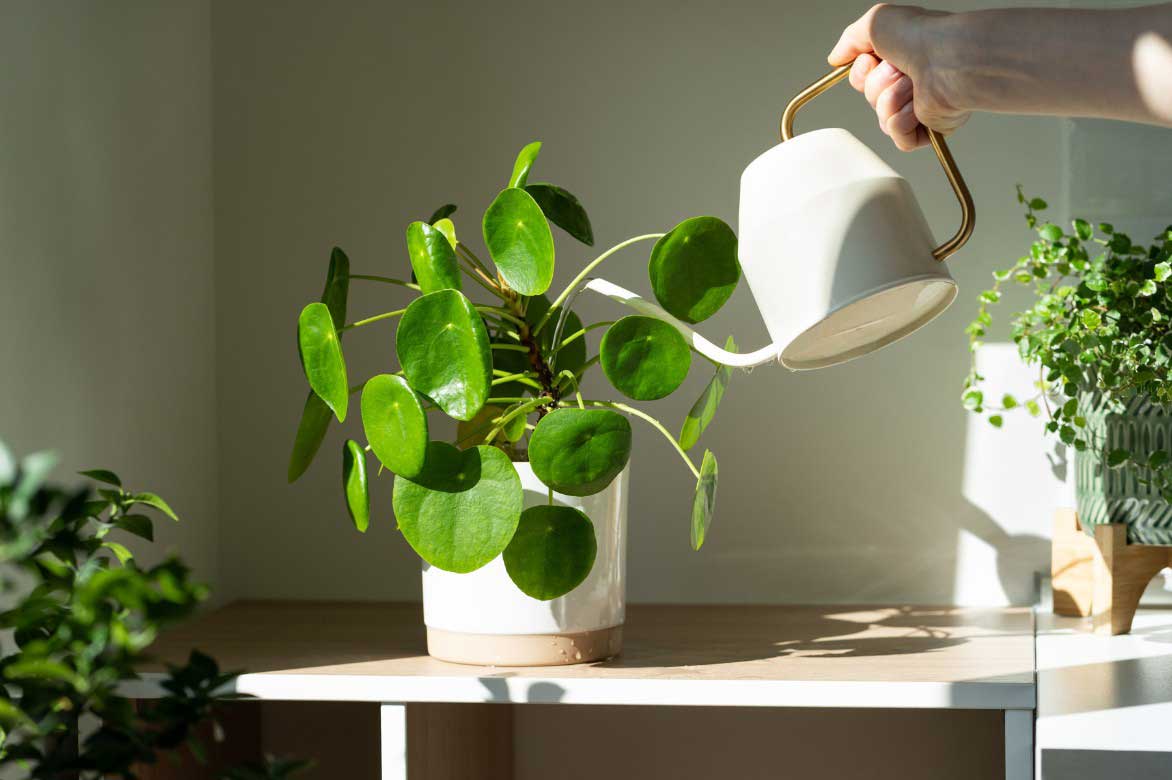
Remember to water the Pilea regularly
Light
As mentioned earlier, the Pilea loves soft light. Rotate the pot regularly to prevent it from growing lopsided as it reaches for the light. Too little light will result in sparse foliage and an unbalanced habit.
Ambient humidity
The Pilea enjoys moderately humid air, especially in winter when heating dries out the air. To compensate, feel free to lightly mist the leaves (not every day). You can also place the pot on a saucer filled with damp clay pebbles (without the bottom of the pot touching the water).
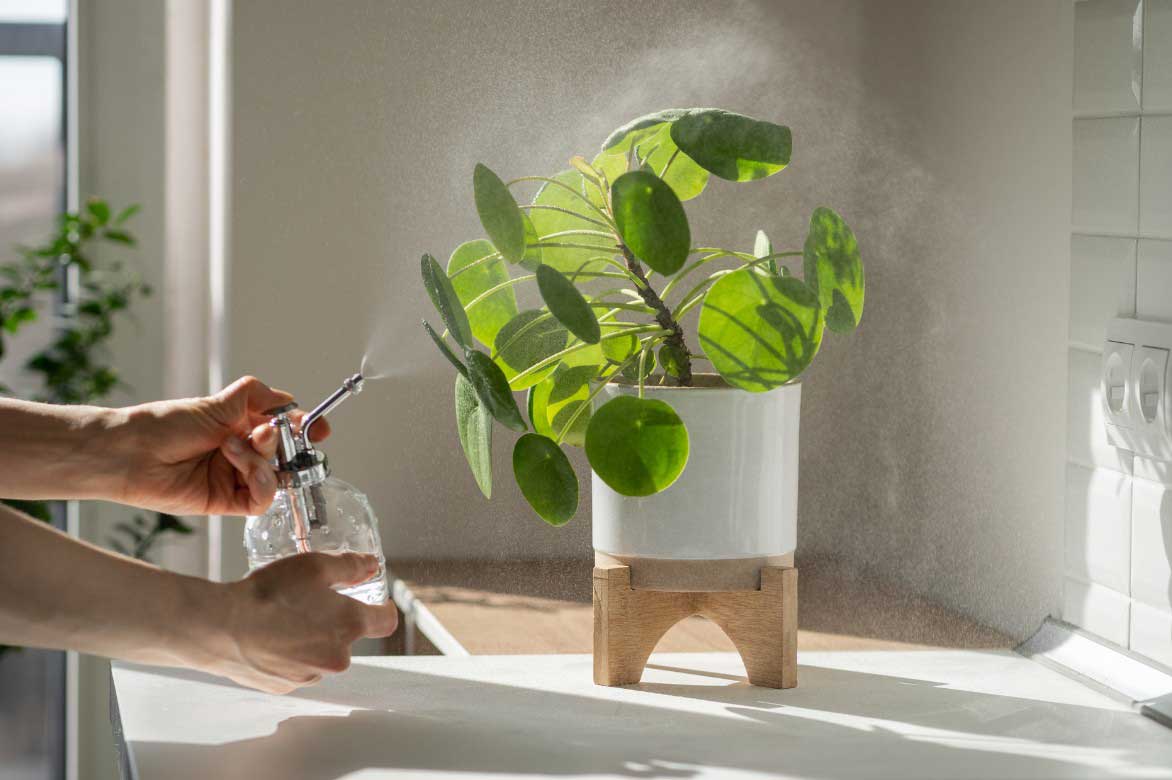
You can mist the foliage occasionally, especially if the air is dry
Pruning and cleaning
- When you notice them, remove yellowed or damaged leaves by cutting them at the base of the stem.
- You can also pinch the stems to encourage branching.
- Clean the leaves with a soft, damp cloth to remove dust (this helps them absorb light better).
Repotting
The Pilea grows quickly! We recommend repotting it every one to two years, in spring. Take the opportunity to partially renew the compost and check the condition of the roots. Each time, place it in a slightly larger pot to accommodate its growth.

Repot the Pilea every one to two years, placing it each time in a slightly larger pot than the previous one
Fertiliser
During the growing season (March to September), you can give it a little liquid fertiliser for houseplants, diluted in the watering water, every 3 to 4 weeks. Stop fertilising in winter.
Diseases and Pests of the Pilea
The Pilea is generally robust, but like any houseplant, it can sometimes encounter a few issues, especially if the growing conditions are not ideal.
Common diseases
- Root rot: it is often caused by excess water or poor drainage. The roots turn black and soft, the leaves yellow and then fall.
Solution: repot the plant in well-draining soil, remove the rotten roots, and reduce watering. - Leaf spots: brown or black spots may appear due to excess moisture on the foliage or a fungal infection.
Solution: avoid wetting the leaves, space out the plants to improve air circulation, and treat with a mild fungicidal if necessary. - Soft or drooping leaves: this may indicate water stress, either from lack of water or overwatering.
Solution: check the soil moisture and adjust watering accordingly.
Common parasites
- Mealybugs: they often appear as small white cottony masses at the base of the leaves.
Solution: remove them by hand with a cotton swab dipped in 70% alcohol, or use a natural insecticidal. - Aphids: these small green or black insects gather on young shoots.
Solution: spray with soapy water or a treatment based on black soap. - Spider mites: present especially in dry conditions, they leave fine webs and cause dull foliage.
Solution: increase ambient humidity, mist regularly, and treat with an acaricide if needed.
Prevention is better than cure: keep an eye on the condition of the leaves, adjust watering, and ventilate the room regularly.
How to propagate Pilea?
The Pilea is particularly appreciated for its ability to naturally produce young shoots, commonly referred to as “offsets.” It is one of the easiest plants to propagate, even for beginners. This allows you to share cuttings with loved ones or expand your own collection at minimal cost.
Propagating Pilea by Removing Offsets
Small shoots sometimes appear at the base of the mother plant, often slightly buried in the compost. These can be removed to propagate the plant. This is, in fact, the simplest and most common method for obtaining new young plants.
When to Remove the Offsets?
Wait until they are about 5 to 10 cm tall and have a few leaves.
How to Do It?
- Carefully dig up the plant to access the offsets.
- Separate the offset with a portion of its roots (if possible).
- Replant the offset in a small pot with a light substrate.
- Water lightly and place the pot in a bright spot, away from direct sunlight.
Recovery is usually quick. You can also leave a few offsets in the same pot as the mother plant for a bushier effect.
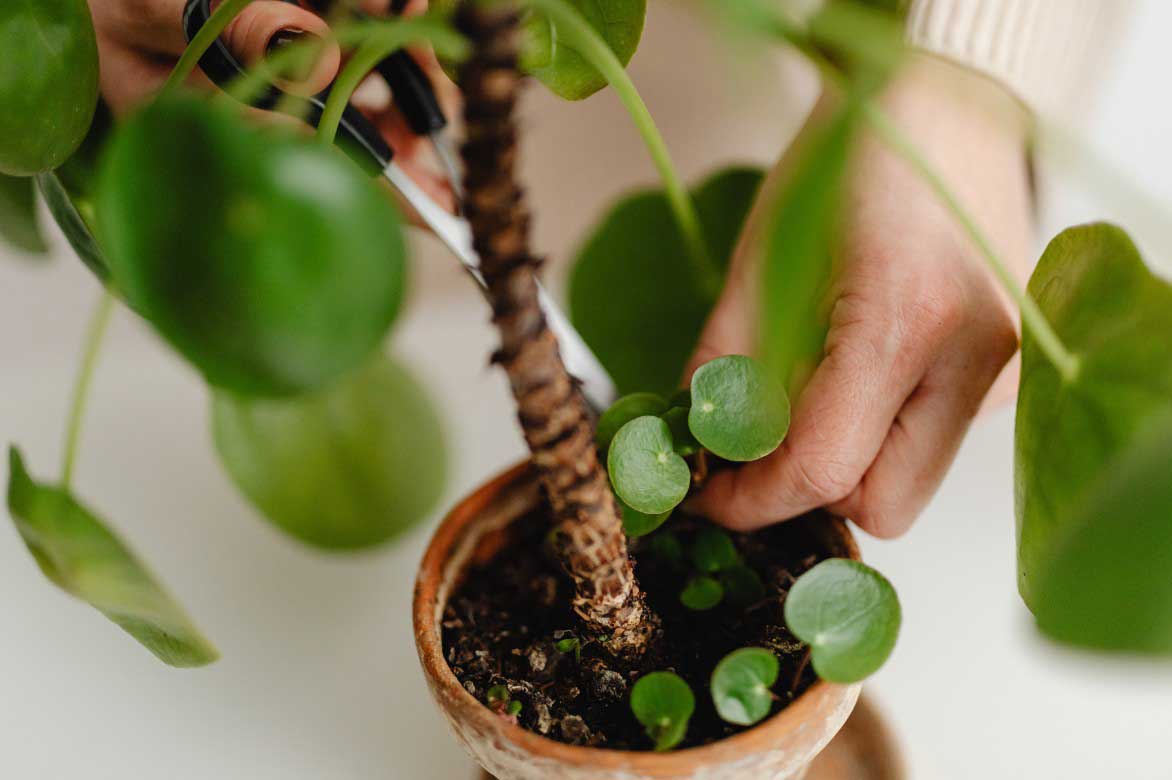
You can remove the offsets growing at the base of the plant
How to Propagate Pilea by Cuttings?
Propagation by cuttings is less common for Pilea, but it is possible if you prune your plant.
- Take a healthy stem about 10 cm long, with 2 or 3 leaves.
- Place it in water, removing the leaves at the base to prevent them from soaking.
- Change the water every 2-3 days.
- In 10 to 15 days, roots should appear.
- Once the roots are sufficiently developed, repot in a small pot.
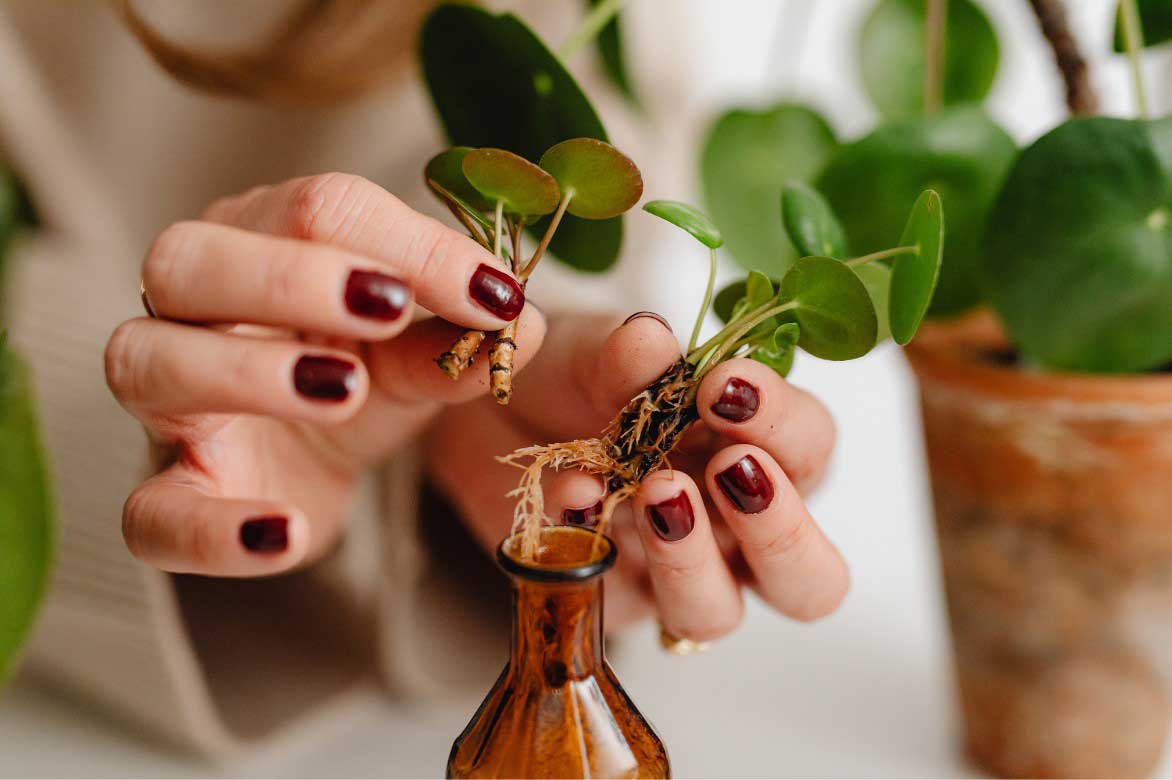
Place the cuttings in water to root before repotting them in a pot
Which plants pair well with Pilea and how to showcase it?
The Pilea pairs particularly well with other houseplants thanks to its rounded and graphic foliage, which creates an interesting contrast with more slender or textured forms. An excellent combination is to place it next to ferns, whose light and delicate fronds highlight the Pilea’s crisp structure. The Calatheas, with their large, veined and often variegated leaves, create a very successful play of textures, while sharing the same preferences for soft light and moderate humidity.
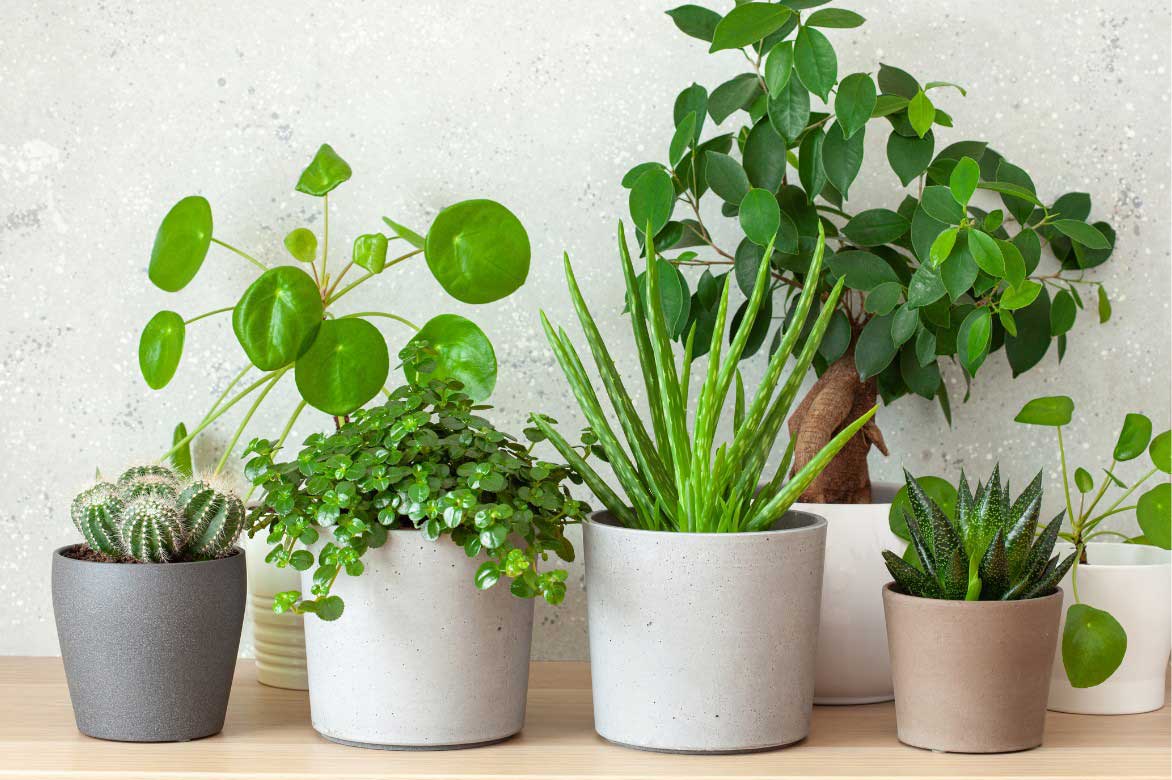
From left to right: Parodia warasii, Pilea peperomioides, Pilea depressa, Aloe vera, Ficus ginseng, Gasteria duval
For a more modern or minimalist vibe, you can pair the Pilea with succulents like Haworthia or Senecio rowleyanus (nicknamed “string of pearls”), which offer a low or trailing habit contrasting with the Pilea’s upright form. The Peperomias, especially those with thick or veined leaves, are also excellent companions for pots or windowsills. Together, they form a compact and easy-to-maintain little ecosystem.
The Pilea can also find its place in an urban jungle corner alongside small monstera, philodendrons, or pothos, which add volume and height around its more compact silhouette. This arrangement works particularly well on a plant shelf or a low piece of furniture lit by natural light.
Finally, in an open terrarium or a large container, it can accompany miniature plants like fittonias, small-leaved pileas, or decorative mosses. The result is a living plant tableau, rich in shades of green and varied forms.
With a bit of creativity, the Pilea becomes a true centrepiece in any plant composition, thanks to its versatility and unique charm.
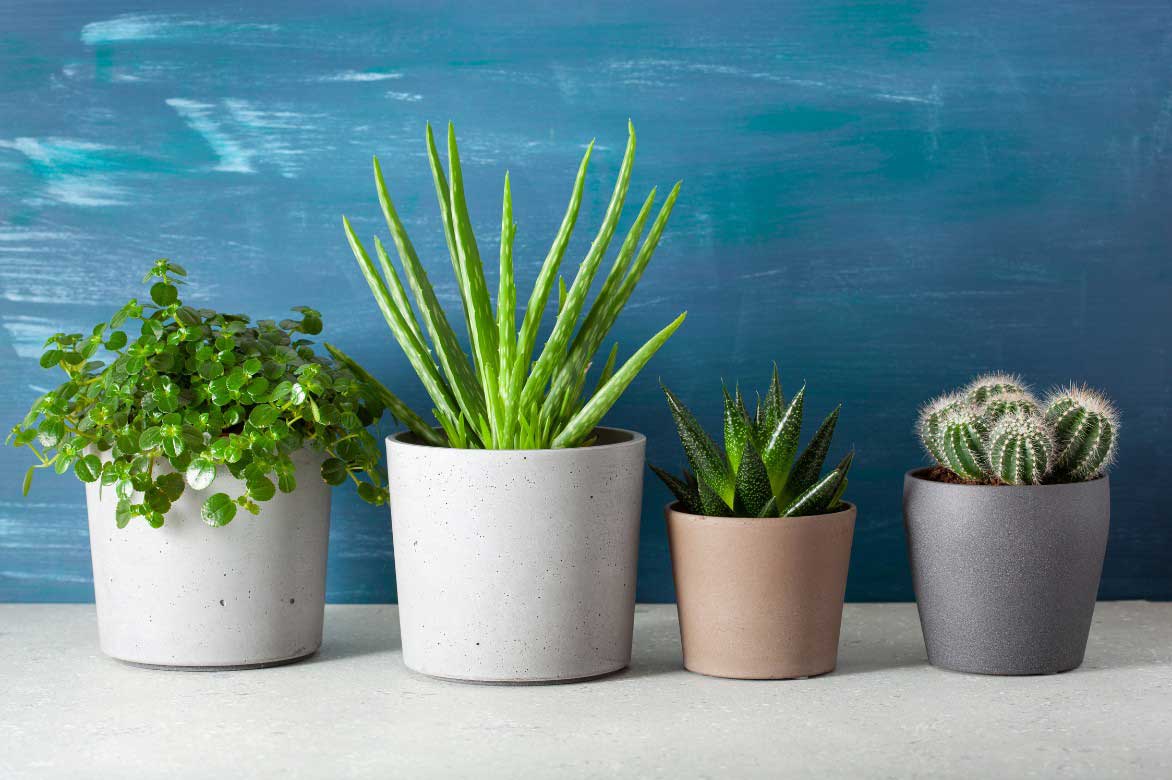
Parodia depressa, Aloe vera, Gasteria duval and Parodia warasii
- Subscribe!
- Contents
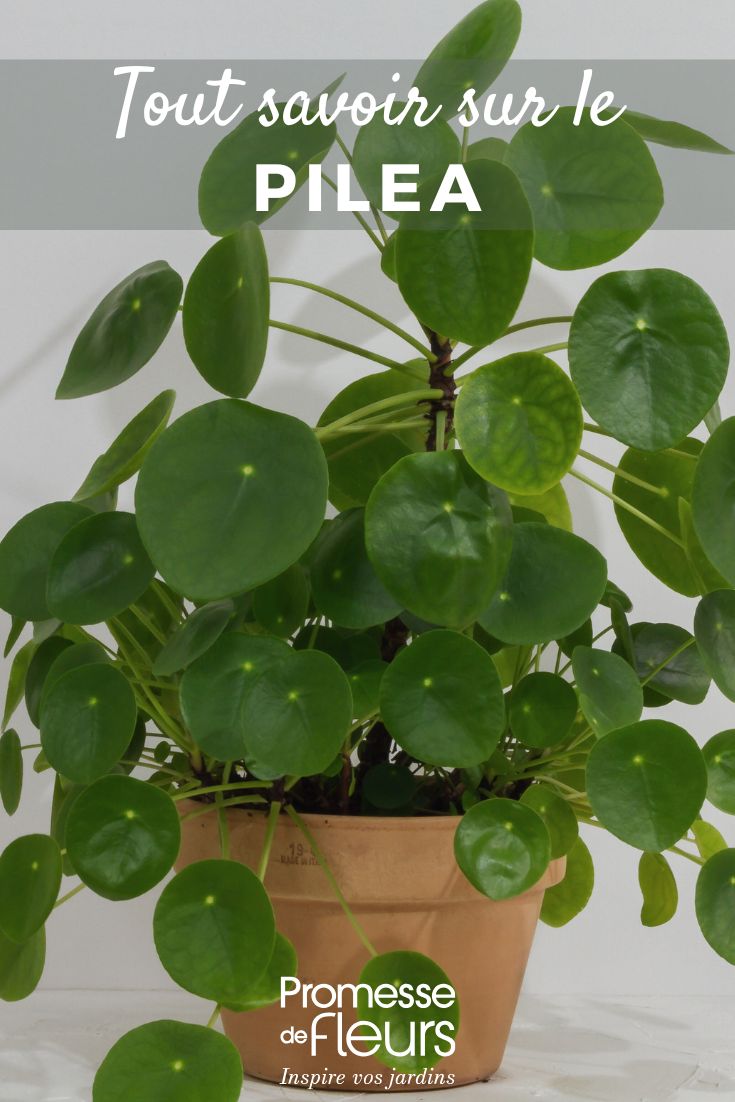































Comments